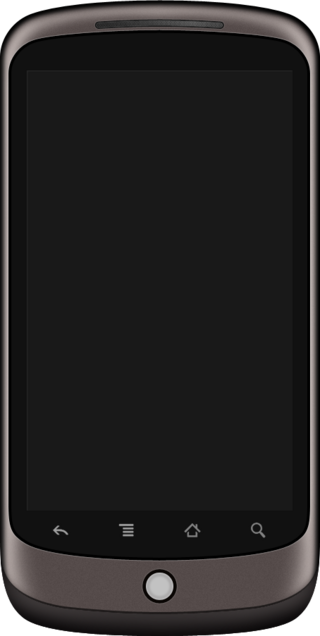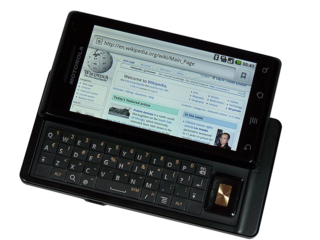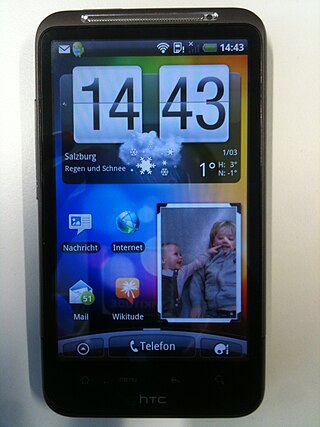Related Research Articles

HTC Corporation, or High Tech Computer Corporation, is a Taiwanese consumer electronics company headquartered in Xindian District, New Taipei City, Taiwan. Founded in 1997, HTC began as an original design manufacturer and original equipment manufacturer and designed and manufactured laptop computers.

Android is a mobile operating system based on a modified version of the Linux kernel and other open-source software, designed primarily for touchscreen mobile devices such as smartphones and tablets. Android is developed by a consortium of developers known as the Open Handset Alliance, though its most widely used version is primarily developed by Google. It was unveiled in November 2007, with the first commercial Android device, the HTC Dream, being launched in September 2008.

The Nexus One is an Android smartphone designed and manufactured by HTC as Google's first Nexus smartphone. The Nexus became available on January 5, 2010, and features the ability to transcribe voice to text, an additional microphone for dynamic noise suppression, and voice guided turn-by-turn navigation to drivers.
A mobile operating system is an operating system for smartphones, tablets, smartwatches, smartglasses, or other non-laptop personal mobile computing devices. While computers such as typical laptops are "mobile", the operating systems used on them are generally not considered mobile ones, as they were originally designed for desktop computers that historically did not have or need specific mobile features. This line distinguishing mobile and other forms has become blurred in recent years, due to the fact that newer devices have become smaller and more mobile unlike hardware of the past. Key notabilities blurring this line are the introduction of tablet computers and light-weight laptops and the hybridization of the two in 2-in-1 PCs.
Google I/O, or simply I/O, is an annual developer conference held by Google in Mountain View, California. The name "I/O" is taken from the number googol, with the "I" representing the "1" in googol and the "O" representing the first "0" in the number. The format of the event is similar to Google Developer Day.

The HTC Dream is a smartphone developed by HTC. First released in September 2008, the Dream was the first commercially released device to use the Linux-based Android operating system, which was purchased and further developed by Google and the Open Handset Alliance to create an open competitor to other major smartphone platforms of the time, such as Symbian, BlackBerry OS, and iPhone OS. The operating system offers a customizable graphical user interface, integration with Google services such as Gmail, a notification system that shows a list of recent messages pushed from apps, and Android Market for downloading additional apps.

The Motorola Droid is an Internet and multimedia-enabled smartphone designed by Motorola, which runs Google's Android operating system. The Droid had been publicized under the codenames Sholes and Tao and the model number A855. In Latin America and Europe, the model number is A853 (Milestone), and in Mexico, the model number is A854 (Motoroi). Due to the ambiguity with newer phones with similar names, it is also commonly known as the DROID 1. The brand name Droid is a trademark of Lucasfilm licensed to Verizon Wireless.

The HTC Desire is the first smartphone of the Desire series developed by HTC. It was announced on 16 February 2010 and released in Europe and Australia in the second quarter of the same year. The HTC Desire was HTC's third flagship phone running Android 2.1 Eclair which can be upgraded to 2.2 Froyo or 2.3 Gingerbread. Internally it bears a strong resemblance to the Nexus One, but differs in some features.

The HTC Droid Incredible (ADR6300) is a smartphone manufactured by HTC Corporation using the Android operating system. It was released on April 29, 2010, and is available through Verizon Wireless only. The device is similar to the Sprint HTC Evo 4G. The device has been succeeded by the HTC Incredible S and the HTC ThunderBolt. The device's "end of life" was March 30, 2011.
Google Nexus is a discontinued line of consumer electronic devices that run the Android operating system. Google managed the design, development, marketing, and support of these devices, but some development and all manufacturing were carried out by partnering with original equipment manufacturers (OEMs). Alongside the main smartphone products, the line also included tablet computers and streaming media players; the Nexus started out in January 2010 and reached its end in October 2016, replaced by Google Pixel.

The HTC Desire HD is an Android smartphone by HTC Corporation. It was unveiled at a press event in London hosted by HTC on September 15, 2010, and was made available for sale in October in Europe and in January 2011 in Canada. The Desire was HTC's fourth flagship Android device until the release of their new line of flagship model, the HTC Sensation.

The HTC Desire Z is a slider-style smartphone developed by HTC Corporation and announced on 15 September 2010; it was released in Europe and Canada in November 2010, following a number of delays related to Google's quality assurance tests. Other than its slider configuration, the Desire Z features specifications similar to the HTC Desire and the HTC Desire HD. The design of the HTC Desire Z has capacitive face buttons rather than the mechanical ones the HTC Desire features.

The Nexus S 4G is a smartphone co-developed by Google and Samsung and manufactured by Samsung Electronics for release in 2010. It was the first smartphone to use the Android 2.3 "Gingerbread" operating system, and the first Android device to support Near Field Communication (NFC) in both hardware and software.
The version history of the Android mobile operating system began with the public release of its first beta on November 5, 2007. The first commercial version, Android 1.0, was released on September 23, 2008. The operating system is developed by Google on a yearly cycle since at least 2011. New major releases are announced at Google I/O along with its first public beta to supported Google Pixel devices. The stable version is then released later in the year.

The HTC Sensation is a smartphone designed and manufactured by HTC Corporation that runs the Android 2.3 Gingerbread software stock. Officially announced by HTC on April 12, 2011, the HTC Sensation was launched by Vodafone in key European markets including the United Kingdom on May 19, 2011 and by T-Mobile in the United States on June 12, 2011. It was HTC's fifth flagship Android phone and the first HTC phone to support the HTC Sense 3.0 user interface. At the time of its release, the Sensation XE was the world's fastest Android phone.

HTC One is a touchscreen-based Android smartphone designed, developed, and manufactured by HTC. The smartphone was unveiled on 19 February 2013 at press events in New York City and London and is HTC's seventh flagship smartphone. It has been hailed by many as a revolutionary Android handset with its premium design and build quality and its emphasis on high end audio. It is the successor to the company's 2012 flagship model, the One X—which was critically acclaimed, but commercially unsuccessful due in part to insufficient marketing efforts. To make the device stand out among its competition, HTC One was developed with a major emphasis on unique hardware and software features; which included a unibody aluminum frame, a 1080p full-HD display, dual front-facing stereo speakers, a camera with a custom image sensor and the ability to automatically generate montages of media, an updated version of HTC's Sense user experience, BlinkFeed—an aggregator of news and social network content, and an electronic program guide app with the ability to serve as a universal remote via an IR blaster located in the device's power button.

The HTC One (M8) is an Android or Windows smartphone manufactured and marketed by HTC. Following a number of leaks that occurred during the months prior, the device was officially unveiled in a press conference on March 25, 2014, and released the same day by Verizon Wireless at retail, and by other Canadian and United States carriers for online orders prior to its wider retail availability in mid-April.

Wear OS is a version of Google's Android operating system designed for smartwatches and other wearables. By pairing with mobile phones running Android version 6.0 "Marshmallow" or newer, or iOS version 10.0 or newer with limited support from Google's pairing application, Wear OS integrates Google Assistant technology and mobile notifications into a smartwatch form factor.

Daydream is a discontinued virtual reality (VR) platform which was developed by Google, primarily for use with a headset into which a smartphone is inserted. It is available for select phones running the Android mobile operating system that meet the platform's software and hardware requirements. Daydream was announced at the Google I/O developer conference in May 2016, and the first headset, the Daydream View, was released on November 10, 2016. To use the platform, users place their phone into the back of a headset, run Daydream-compatible mobile apps, and view content through the viewer's lenses.
The Pixel Watch is a Wear OS smartwatch designed, developed, and marketed by Google as part of the Google Pixel product line. First previewed in May 2022 during the Google I/O keynote, it features a round dome-shaped display as well as heavy integration with Fitbit, which Google acquired in 2021. Two Pixel-branded smartwatches had been in development at Google by July 2016, but they were canceled ahead of their release due to hardware chief Rick Osterloh's concerns that they did not fit well with other Pixel devices. Development on a new Pixel-branded watch began shortly after Google's acquisition of Fitbit.
References
- ↑ "Android Already Has Phandroids" Wired 06 November 2007.
- ↑ "First Android Gingerbread Details" Phandroid 18 October 2010
- ↑ "Android Wear reportedly getting watch-to-watch sharing features". Engadget 13 July 2015.
- ↑ "Twitter's tablet-optimized Android app leaks out" The Verge.com 8 September 2013.
- ↑ "This Is Probably HTC’s Next Big Android Phone, The One M9" TechCrunch 22 February 2015.